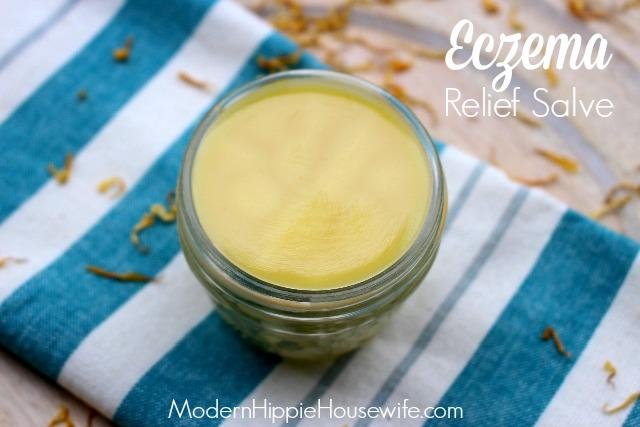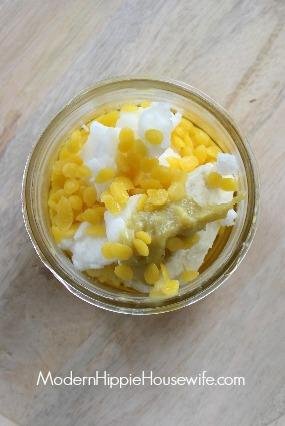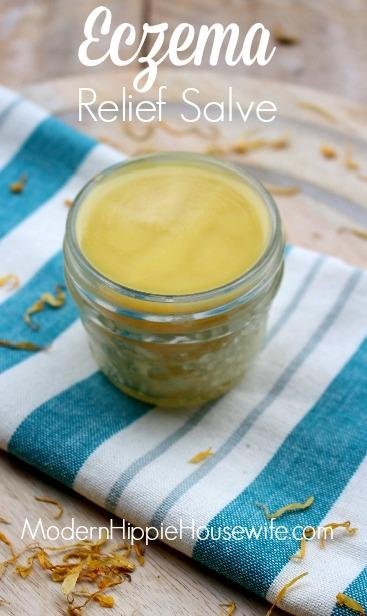Homemade Eczema Relief Salve
This post contains affiliate links. I make a small commission on products purchased through the links on this site in order to support my blogging practice, however, this does not affect the price for you. I would never promote a product that I wouldn’t use myself.
If you're reading this, then most likely either you, or someone you care about, struggle with the discomfort of itchy, scaly, annoying, and down right baffling, eczema. And like me, you've probably scoured the internet for answers only to find that there is no single cause for eczema, there is "no known cure," and that the recommended treatment is steroid creams. This is frustrating, I know. And although I can't tell you for certain what is causing your eczema, I can share with you my homemade eczema relief salve recipe, which I am confident will soothe your symptoms.
But first, since we're all friends here, I want to share with you my personal history with eczema...
My eczema first appeared on the back of my knees and elbows when I was just a baby. It went away and then re-appeared in fourth grade on my hands and wrists. Then again, it subsided and didn't re-appear until University where it would show up on my eye-lids, of all places, and around my nose, during exam time. After the stress of University was behind me, I thought that my eczema was gone for good...and then I got pregnant. After I had my daughter, I developed a myriad of allergies and weird hormonal changes which were accompanied by my old pal, eczema. This time, I developed dyshidrotic eczema, which appears as hundreds of small, itchy blisters, all over the palms of my hands, and seborrheic dermatitis which you can see, to this day, around my nose and chin, and is, what I like to call, my "eczema goatee." Yes, nothing's more attractive then an eczema goatee.
So there's a little bit about my history with eczema, and although I sometimes can't believe that I'm sharing this kind of personal information with the world (like my eczema goatee, for example) I do it in hopes that someone will read it and be able to relate, and hopefully find what I'm about to tell you useful.
What causes eczema?
Eczema is a broad term, and is generally used to describe a rash-like skin condition or atopic dermatitis.
Both internal and external factors can bring on eczema symptoms, which makes it difficult pinpoint the source. Eczema that is caused by external irritants is called contact dermatitis, and can be triggered by such things as detergents, pollen, temperature change, bacteria, viruses and fungi. Eczema can also be triggered by internal reactions that likely start in your gut and are often accompanied by other allergic responses such as hayfever and asthma.
Internal triggers may be linked to:
- food allergies, commonly, dairy, nuts, eggs, soy and wheat
- stress, which is not a cause but can make symptoms worse
- hormonal changes (a big factor for me)
- poor digestion
- low stomach acid
- a weak immune system
- a family history of allergies and eczema
Your eczema is likely surfacing because something internally is off balance, and your skin is being affected because your system is trying to detoxify itself. Thus, addressing your overall health should be your primary concern!
Ask yourself this:
- Am I eating a whole-foods/real-food diet?
- Am I drinking plenty of water?
- Am I getting daily exercise?
- Are my relationships healthy and enjoyable? (remember, stress is a huge factor)
- Is my job weighing down on me?
- Do I get a good rest?
- Do I regularly go poop? (this is important in order to detoxify and move waste through the body)
- Do I use detergents in my laundry and cleaning products?
Now, trust me, I understand how difficult it is to pinpoint your flare-ups - I often feel like they're coming out of no-where! But, there likely is a source, and paying attention to your overall health is the first step to addressing the cause. The truth is, you may need to make some major adjustments in your life if want to get to the bottom of your eczema. There is no easy or quick fix.
The problem with steroid creams, which are almost always prescribed to eczema sufferers, is that they don't get to the root of the problem. They are topically applied and trigger specific hormones in your body to inhibit the allergic response. Now don't get me wrong, I am very grateful for western medicine, and have used steroid creams when my hands were so blistered and swollen that I couldn't even bend my fingers, but I don't think it is the solution. Becoming dependent on these creams comes with their side-affects, and like I said, getting to the root of the problem should be your primary concern.
For days when my eczema flares-up, I rely on my own Homemade Eczema Relief Salve.
This salve is NOT a cure, however, if you do get an unexpected flare-up, an external healing salve can help reduce the overall discomfort and appearance of eczema symptoms without the side-effects of steroid creams.
Salve vs. Cream
There are many DIY recipes on the internet for eczema "creams," but I have yet to find one that is a true cream - most are actually salves. This eczema recipe is no exception, which is why I've named it appropriately.
So to clear things up, a salve is a fatty, semi-solid mixture which has an oil base. A salve generally consists of carrier oil, shea butter, cocoa butter, and beeswax, with some essential oils.
A cream, on the other hand, is water-based, contains some oils, emulsifiers, and likely a preservative.
Homemade Eczema Relief Salve
Although the cause of my eczema is not entirely known, for the days when I have flare ups on my hands and face, I know for certain, that I can apply my homemade eczema relief salve and feel instant relief without having to turn to steroid creams.
This homemade eczema salve is not a cure, however, applying this cream to bumpy, flaky, and itchy affected areas, drastically minimizes the symptoms.
In this salve, I use several ingredients which specifically help soothe eczema symptoms:
- Calendula-infused oil, which is made of castor oil, sunflower oil, and dried calendula flowers. Castor and sunflower oil are great for targeting eczema and will effectively get rid of dead skin cells and help ease irritation. Calendula is used for it's healing properties. I'm lucky that calendula grows like a weed in our yard, but you can also order dried, calendula flowers here. Learn more about calendula and how to make a calendula tincture, here.
- Coconut oil is a popular natural remedy for eczema symptoms. A study published in the International Journal of Dermatology has confirmed the natural healing properties of virgin coconut oil in treating atopic dermatitis, a.k.a, eczema.
- Neem oil is derived from the neem tree in India. When applied to the skin, it is highly moisturizing, is anti-inflammatory, analgesic ( a pain killer), and anti-bacterial. Neem oil is powerful in small quantities, and has a strong odour, which is why only a small amount is added to this eczema relief salve.
- Essential oils also play a big role in this salve. I use German chamomile, tea tree, lavender and bergamot, for their anti-inflammatory, antibacterial and healing properties.
How it's made
The first step to making this salve is to make your calendula-infused oil. This can take about 2-6 weeks (or longer for a more potent oil), if you're using a cold process method. Or, you can use the slow cooker, and have infused oils infused within 8-12 hours.
To do this, fill a jar with dried, calendula petals. Pour equal parts sunflower oil and castor oil over the petals until they are fully submerged, cover with a lid and leave them to infuse using either the solar or slow cooker method.
Learn how to infuse oils via the solar and slow cooker method here!
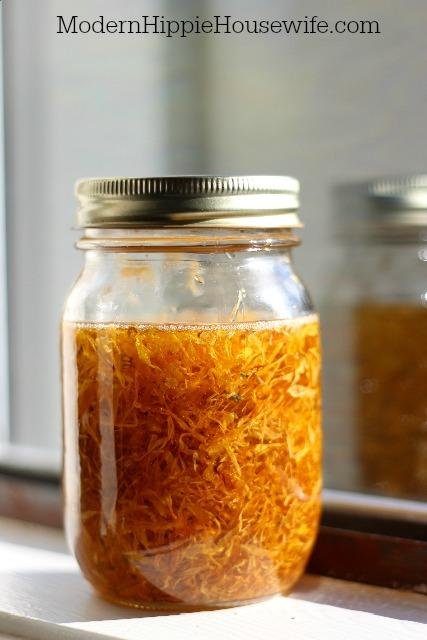
Once you have your calendula-infused oil, you can start assembling the salve.
Ingredients
- 2 tbsp (30 g) shea butter
- 2 tbsp (30 g) coconut oil
- 2 tbsp (30 g)calendula infused castor/sunflower oil
- 1 tsp (5 g) neem oil
- 1 tbsp (15 g) beeswax (grated or pastilles)
- 10-15 drops of each essential oils: German chamomile, tea tree, lavender, bergamot
I highly recommend investing in a kitchen scale if you don't already have one. They make life so much more easy when making homemade salves and lotions and give the most consistent and accurate results.
Measure out all of the ingredients, except the essential oils, into a glass, jar. Place the jar in a pan of simmering water in order to create a double-boiler effect - this will prevent the oils from burning.
Once the oils, butters and wax has melted, remove from heat and add the essential oils. Stir to combine and leave to sit at room temperature until the oils have solidified into a salve.
Use the salve on effected areas, as often as you'd like. It makes a great face moisturizer and lip balm too!
Please remember, this is not the cure, and only offers temporary symptom relief. It's time for you to do some self-assessment and narrow down the potential internal and external triggers in order to prevent your eczema from appearing in the first place! Best of luck, and remember, you're not alone!
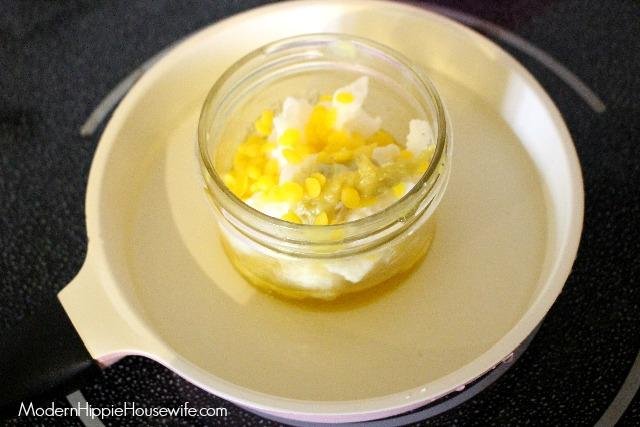
- 2 tbsp (30 g) shea butter
- 2 tbsp (30 g) coconut oil
- 2 tbsp (30 g)caledula infused castor/sunflower oil
- 1 tsp (5 g) neem oil
- 1 tbsp (15 g) beeswax (grated or pastilles)
- 10-15 drops each german chamomile, tea tree, lavender, bergamot
- Measure out all of the ingredients, except the essential oils, into a glass, jar. Place the jar in a pan of simmering water in order to create a double-boiler effect - this will prevent the oils from burning.
- Once the oils have melted, remove from heat and add the essential oils. Stir to combine, and leave to sit, covered, at room temperature, until the oils have solidified into a salve.
- Use the salve on effected areas, as often as you'd like. It makes a great face moisturiser and lip balm too!
Don't want to make it?
No worries, I'll make it for you! I sell this Eczema Relief Salve (aka Everything Cream) in my Modern Hippie Shop!


